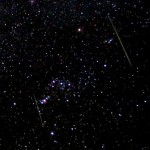The first meteor shower of 2019 is the annual Quadrantid meteor shower. The Quadrantids are a reliable shower, producing 60-120 ZHR, one to two meteors per minute. The Quadrantids are named for the obsolete constellation Quadrans Muralis, now part of the constellation Boötes.
Unlike other showers where activity can occur for days or even weeks, the Quadrantids have a sharp peak, activity falls off rapidly on the preceding and following nights, or even a few hours away from the peak. Thus it is important to observe the Quadrantids quite near the peak prediction.
This year’s peak is calculated for January 4th at 02:20UT, this would be January 3rd at 16:20HST, well timed for observers in Europe, not favorable for observers in these islands. For northern observers the radiant is circumpolar, thus the shower is observable all night long. Given our 20° latitude here in Hawaii the radiant does not rise until 01:30HST, thus observations must wait until well into the morning hours.
New Moon on January 6 creates optimum viewing conditions for the expected Quadrantid maximum on January 4. For many northern hemisphere sites, the shower’s radiant is circumpolar, in northern Boötes, from where it first attains a useful elevation after local midnight, steadily improving through till dawn. The 02h UT timing for the peak will be favourable for European longitudes. The λ⊙ = 283 . ◦16 maximum timing is based on the best-observed return of the shower ever analysed, from IMO data collected in 1992, as confirmed by radio results in most years since 1996. It also coincides with the closest approach to the stream calculated by Jérémie Vaubaillon (λ⊙ = 283 . ◦17). The peak is short-lived with an average duration (full width at half maximum) of about four hours. Hence it can be easily missed if the observer is located outside the “main observing window” – IMO 2019 Meteor Shower Calendar
Watching meteors requires no more equipment than your eyes and a dark sky, and can be enjoyable for just about anyone. While most observers in the northern hemisphere must endure winter conditions to observe this shower, in the islands we have the option of observing from somewhat warmer locations. I think this year’s Quadrantids deserve an early wake-up and a trip into the dark!


